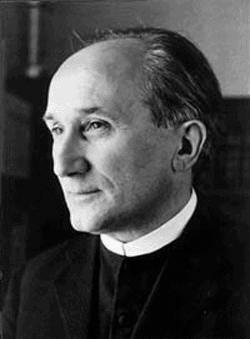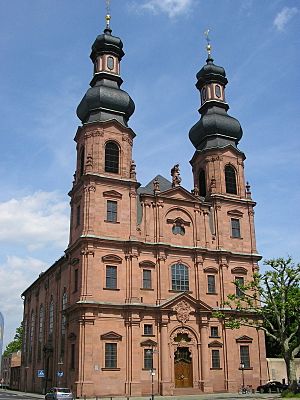Romano Guardini facts for kids
Quick facts for kids Romano Guardini |
|
|---|---|

Guardini in 1920
|
|
| Orders | |
| Ordination | 28 May 1910 (Priest) |
| Personal details | |
| Birth name | Romano Michele Antonio Maria Guardini |
| Born | 17 February 1885 Verona, Italy |
| Died | 1 October 1968 (aged 83) Munich, Germany |
| Alma mater | University of Tübingen University of Freiburg |
Romano Guardini (born February 17, 1885 – died October 1, 1968) was a German Catholic priest. He was also a philosopher and theologian. He became one of the most important thinkers in the Catholic Church during the 20th century.
Contents
Romano Guardini's Life Story
Romano Michele Antonio Maria Guardini was born in Verona, Italy, in 1885. He was baptized in the Church of San Nicolò all'Arena. His family moved to Mainz, Germany, when he was just one year old. He lived in Germany for the rest of his life.
As a young man, Guardini felt worried and very careful about doing things right. He spoke Italian and German fluently. He also learned Latin, Greek, French, and English.
Becoming a Priest
Guardini first studied chemistry at the University of Tübingen. Then he studied economics in Munich and Berlin. After a few semesters, he decided to become a priest. He studied Theology in Freiburg im Breisgau and Tübingen.
He was very impressed by the spiritual life of the monks at Beuron Archabbey. He became a Benedictine oblate, which means he joined their community in a special way. He took the name Odilio. Guardini became a priest in Mainz in 1910.
He worked briefly as a priest at St. Christoph's Church, Mainz. Then he went back to Freiburg to work on his advanced degree in Theology. He earned his doctorate in 1915. He continued his studies and became qualified to teach theology at the University of Bonn in 1922.
During this time, he also worked as a parish priest. He served at St. Ignatius, St. Emmeran's, and St. Peter's. He was also a chaplain for Catholic youth groups. During World War I, he helped as a hospital orderly.
Teaching and Challenges
In 1923, Guardini became a professor at the University of Berlin. He taught about the Philosophy of Religion. In 1935, he wrote an essay called "Der Heiland" (The Saviour). In it, he criticized the Nazis for trying to change the story of Jesus. He stressed that Jesus was Jewish. Because of this, the Nazis forced him to leave his teaching job in Berlin in 1939.
From 1943 to 1945, he lived quietly in Mooshausen. His friend Josef Weiger was a priest there.
Later Life and Honors
After World War II ended in 1945, Guardini became a professor again. He taught at the University of Tübingen. In 1948, he moved to the University of Munich. He taught there until he retired in 1962 due to health reasons.
In 1962, he received the Erasmus Prize. This award is given to people who have made great contributions to culture or society in Europe. In 1965, Pope Paul VI offered to make Guardini a cardinal. This is a very high position in the Catholic Church, but Guardini politely said no.
Romano Guardini passed away in Munich, Bavaria on October 1, 1968. He was buried in a cemetery for priests in Munich. He left his writings and belongings to the Catholic Academy in Bavaria, which he had helped start.
In 2017, the Catholic Church began the process to make Guardini a saint. This means he is now called a Servant of God.
Why Was Romano Guardini Important?
Guardini's books often explored old ideas in new ways. He looked at today's problems through the eyes of Christian and Catholic traditions. He could understand the ideas of thinkers like Socrates, Plato, Augustine, and Dante. He made their ideas understandable for people living in modern times.
Influence on Worship
His first major book, Vom Geist der Liturgie (The Spirit of the Liturgy), was published during World War I. This book greatly influenced the Liturgical Movement in Germany. This movement aimed to make church services (liturgy) more meaningful. His ideas also helped shape the changes made to Catholic worship during the Second Vatican Council.
Guardini is seen as the leader of the liturgical movement in Germany. He believed that worship should involve the whole person, not just their mind. He wanted people to truly experience religious actions, not just go through the motions. For example, he thought a procession should be a real religious journey with God, not just people walking in a line.
Influence on Other Thinkers
Guardini didn't start a specific "school" of philosophy. However, many important thinkers were influenced by him. These include Josef Pieper, Luigi Giussani, and even future popes. Joseph Ratzinger (who became Pope Benedict XVI) and Jorge Mario Bergoglio (who became Pope Francis) both studied Guardini's work. Pope Francis even quoted Guardini's book The End of the Modern World many times in his 2015 encyclical Laudato si'.
Guardini's work became popular again in the 1990s. Many of his books were re-released. In 1997, his remains were moved to the Sankt Ludwig Kirche in Munich. This was the church where he often preached.
Guardini's book The Lord was very successful. It stayed in print for many years. The famous writer Flannery O'Connor thought it was "very fine" and told her friends to read it.
Books by Romano Guardini
- Pascal: A Study in Christian Consciousness. Cluny Media, 2022. ISBN: 978-1685951139
- The End of the Modern World. Sheed & Ward, 1957. More recently in a revised edition by ISI Books, 1998. ISBN: 978-1-882926-23-7
- The Art of Praying: The Principles and Methods of Christian Prayer. Sophia Institute Press, 1994. ISBN: 978-0-918477-21-7
- The Lord. Regnery Publishing, 1996. ISBN: 978-0-89526-714-6 with introduction by Cardinal Joseph Ratzinger
- The Essential Guardini: An Anthology, edited by Heinz R. Kuehn. Liturgy Training Publications, 1997. ISBN: 978-1-56854-133-4
- The Spirit of the Liturgy. Crossroad Publishing, 1998. ISBN: 978-0-8245-1777-9
- Living the Drama of Faith. Sophia Institute Press, 1999. ISBN: 978-0-918477-77-4
- Learning the Virtues. Sophia Institute Press, 2000. ISBN: 978-0-918477-64-4
- The Death of Socrates. Kessinger Publishing, 2007. ISBN: 978-1-4325-5430-9
- The Rosary of Our Lady. Sophia Institute Press, 1998.
- Sacred Signs. CreateSpace Independent Publishing Platform, 2015. ISBN: 978-1-5088-3208-9
- The Humanity of Christ: Contributions to a Psychology of Jesus. Cluny Media, 2018. ISBN: 978-1-949899-29-0
- The Human Experience: Essays on Providence, Melancholy, Community, and Freedom. Cluny Media, 2018. ISBN: 978-1-944418-84-7
- The Meaning of the Church. Cluny Media, 2018. ISBN: 978-1-944418-99-1
- The Spirit of the Liturgy. Cluny Media, 2018. ISBN: 978-1-944418-67-0
- The Death of Socrates. Cluny Media, 2019. ISBN: 978-1-949899-42-9
- Rilke's Duino Elegies: An Interpretation. Cluny Media, 2019. ISBN: 978-1-952826-46-7
- The Last Things. Cluny Media, 2019. ISBN: 978-1-949899-48-1
- The Conversion of Augustine. Cluny Media, 2020. ISBN: 978-1-952826-46-7
See also
 In Spanish: Romano Guardini para niños
In Spanish: Romano Guardini para niños


